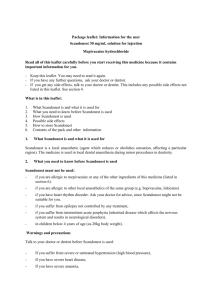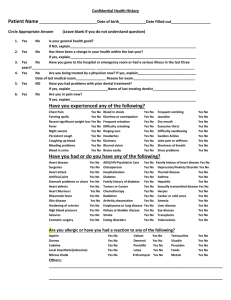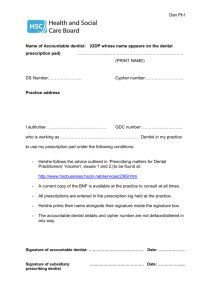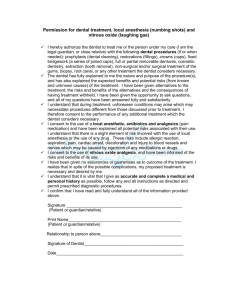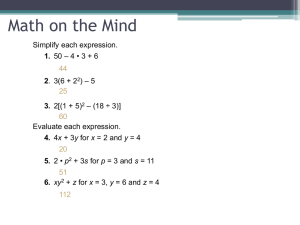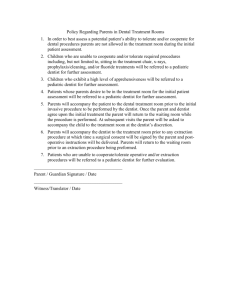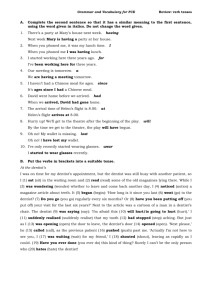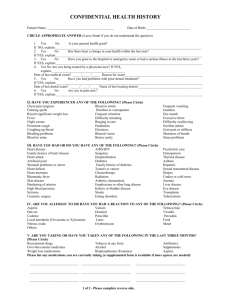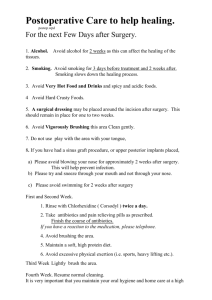Septocaine forte, Septocaine solution for injection ENG PL
advertisement
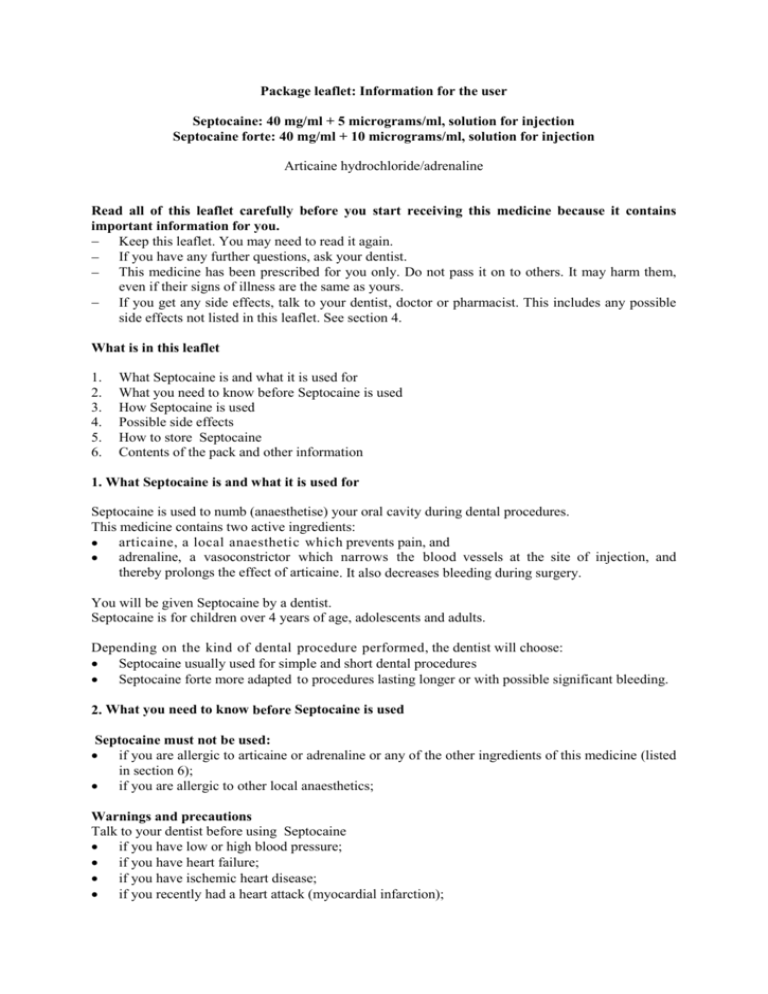
Package leaflet: Information for the user
Septocaine: 40 mg/ml + 5 micrograms/ml, solution for injection
Septocaine forte: 40 mg/ml + 10 micrograms/ml, solution for injection
Articaine hydrochloride/adrenaline
Read all of this leaflet carefully before you start receiving this medicine because it contains
important information for you.
Keep this leaflet. You may need to read it again.
If you have any further questions, ask your dentist.
This medicine has been prescribed for you only. Do not pass it on to others. It may harm them,
even if their signs of illness are the same as yours.
If you get any side effects, talk to your dentist, doctor or pharmacist. This includes any possible
side effects not listed in this leaflet. See section 4.
What is in this leaflet
1.
2.
3.
4.
5.
6.
What Septocaine is and what it is used for
What you need to know before Septocaine is used
How Septocaine is used
Possible side effects
How to store Septocaine
Contents of the pack and other information
1. What Septocaine is and what it is used for
Septocaine is used to numb (anaesthetise) your oral cavity during dental procedures.
This medicine contains two active ingredients:
articaine, a local anaesthetic which prevents pain, and
adrenaline, a vasoconstrictor which narrows the blood vessels at the site of injection, and
thereby prolongs the effect of articaine. It also decreases bleeding during surgery.
You will be given Septocaine by a dentist.
Septocaine is for children over 4 years of age, adolescents and adults.
Depending on the kind of dental procedure performed, the dentist will choose:
Septocaine usually used for simple and short dental procedures
Septocaine forte more adapted to procedures lasting longer or with possible significant bleeding.
2. What you need to know before Septocaine is used
Septocaine must not be used:
if you are allergic to articaine or adrenaline or any of the other ingredients of this medicine (listed
in section 6);
if you are allergic to other local anaesthetics;
Warnings and precautions
Talk to your dentist before using Septocaine
if you have low or high blood pressure;
if you have heart failure;
if you have ischemic heart disease;
if you recently had a heart attack (myocardial infarction);
if you recently had coronary artery bypass surgery;
if you have fast irregular heartbeat (tachyarrhytmia);
if you suffer from severe heartbeat coordination problems (cardiac disorders, atrioventricular
block);
if you have problems with your blood vessels (e.g. narrowing and hardening of the arteries that
supply the legs and feet);
if you are epileptic;
if you lack a natural chemical substance called cholinesterase in your blood (plasma
cholinesterase deficiency);
if your thyroid is severely overfunctioning (thyrotoxicosis);
if you have a tumour called pheochromocytoma;
if you have problems with your liver;
if you have problems with your kidney;
if you suffer from a disease called Myasthenia Gravis causing weakness in the muscles;
if you suffer from a condition called Porphyria which causes either neurological complications or
skin problems;
if you have diabetes;
if you suffer from a disease called angle-closure glaucoma which affects your eyes;
if you have inflammation or infection in the area to be injected
if you are more than 70 years old.
Children
Septocaine should not be used in children under 4 years of age.
Other medicines and Septocaine
Tell your dentist if you are taking, have recently taken or might take any other medicines.
Your dentist should take special attention if you are taking the following medicines:
other local anesthetics, medicines that cause reversible loss of sensation (including volatile
anaesthetics such as halothane);
sedatives (such as benzodiazepine, opioids): this warning only concerns children;
neuroleptic drugs (for example phenothiazines)
heart and blood pressure medicines
tricyclic antidepressants used to treat depression (such as amitriptyline, desipramine, imipramine,
nortriptyline, maprotiline and protriptyline)
COMT-inhibitors to treat Parkinson’s disease (such as entacapone or tolcapone)
medicines used to treat irregular heartbeats (for example digitalis, quinidine)
medicines used for migraine attacks (such as methysergide or ergotamine)
medications preventing blood clotting (antiplatelets, anticoagulants)
sympathomimetic vasopressor such as oxymetazoline used to treat swelling or inflammation of
the nose
If sympathomimetic vasopressor such as cocaine, amphetamines, phenylephrine, pseudoephedrine,
oxymetazoline have been used within the past 24 hours, the planned dental treatment has to be
postponed.
Septocaine with food
You should avoid chewing gum or eating until normal sensation is restored after using this medicine.
Otherwise there is a risk that you will bite your lips, cheeks or tongue.
Pregnancy and breast-feeding
If you are pregnant or breast-feeding, think you may be pregnant or are planning to have a baby, ask
your dentist or doctor for advice before using this medicine.
Your dentist or doctor will decide if you can use Septocaine during pregnancy or breast-feeding.
If Septocaine is used during breast-feeding, the nursing mother is advised to express and discard the
first milk after using Septocaine.
Driving and using machines
If you experience side effects, including dizziness, blurred vision or fatigue, you should not drive or
operate machinery until these effects have disappeared.
Septocaine contains sodium and sodium metabisulfite.
Sodium: less than 23 mg sodium per cartridge, meaning it is essentially "sodium free".
Sodium metabisulfite: it may rarely cause severe allergic reactions and breathing difficulties
(bronchospasm).
3. How Septocaine is used
Your dentist will choose between Septocaine and Septocaine Forte and adjust the dosage according to
your age, your health and the dental procedure. The lowest dose leading to efficient anaesthesia should
be used.
Septocaine is given as an injection in the oral cavity.
If your dentist uses more Septocaine than he or she should
If you think you may have been given too much of this injection and feel unwell, tell your dentist.
Symptoms of overdose include loss of consciousness, severe weakness, headache, feeling restless,
feeling disorientated, dizziness, involuntary trembling or quivering, coma, convulsions, speech
disorders, losing your balance, dilation of the pupil, blurred vision, problems clearly focusing an
object (accommodation disorder), paleness of the skin, abnormally slow or rapid breathing rate which
could lead to temporarily stopping breathing, yawning, and failure of the heart to contract effectively
(called cardiac arrest).
If you have any further questions on the use of this product, ask your dentist.
4. Possible side effects
Like all medicines, this medicine can cause side effects, although not everybody gets them.
While you are in your dentist’s office, your dentist will carefully follow the effects of Septocaine.
Inform your dentist, doctor or pharmacist immediately if you experience one of the following
serious side effects:
Swollen face, tongue or pharynx, difficulty to swallow, hives or difficulties to breath
(angioedema)
rash, itching, swelling of the throat and difficulty breathing: this might be symptoms of an allergic
(hypersensitivity) reaction.
Horner's syndrome – a combination of drooping of the eyelid and constriction of the pupil
These side effects happen rarely (may affect up to 1 in 1,000 people ).
Other other side effects not listed above may also occur in some patients.
Common side effects: may affect up to 1 in 10 people:
abnormal rapid heartbeat
abnormal slow heartbeat
low blood pressure
swelling of tongue, lips and gums, inflammation of gums, numbness of your tongue mouth and
lips
numbness or reduced sense of touch in and around the mouth
metallic taste, taste disturbance or loss of taste function
increased, unpleasant or abnormal sense of touch
neuropathic pain – pain due to nerve damage
increased sensitivity to heat
Uncommon side effects: may affect up to 1 in 100 people:
burning sensation
high blood pressure
inflammation of the tongue and mouth
nausea, vomiting, diarrhea
rash, itching
pain in the neck or at the site of the injection
Rare side effects: may affect up to 1 in 1,000 people:
wheezing (bronchospasm), asthma
hives (urticarial)
nervousness, anxiety
somnolence
facial nerve disorder (paralysis)
involuntary eye movement
double vision, temporary blindness
drooping or falling of the upper or lower eyelid, constriction of the pupil
the posterior displacement of the eyeball within the orbit due to changes in the volume of the orbit
– called Enophthalmos
ringing of the ears, over-sensitivity of hearing
palpitations
hot flush
difficulty breathing
exfoliation and ulceration of the gums
muscle twitch, involuntary muscle contraction
chills
exfoliation of the injection site
fatigue, weakness
Very rare side effects: may affect up to 1 in 10,000 people:
persistent loss of sensitivity, extended numbness and loss of taste
Not known: frequency cannot be estimated from the available data
extremely good mood (euphoria)
heartbeat coordination problems (conduction disorders, atrioventricular block)
widening or narrowing of blood vessels
hoarseness
difficulty in swallowing
redness of the skin (erythema)
worsening of the neuromuscular symptoms in Kearns-Sayre syndrome
local swelling
abnormally increased sweating, feeling hot or feeling cold
Reporting of side effects
If you get any side effects, talk to your dentist, doctor or pharmacist. This includes any possible side
effects not listed in this leaflet.
You can also report side effects directly via the the national reporting system listed in Appendix V. By
reporting side effects you can help provide more information on the safety of this medicine.
5. How to store Septocaine
Keep this medicine out of the sight and reach of children.
Your dentist will not use this medicine after the expiry date which is stated on the carton. The expiry
date refers to the last day of that month.
Your dentist will not store it above 25° C.
He/she will keep the cartridges in the outer carton in order to protect from light and moisture.
This medicine should not be refrigerated or frozen.
Before giving you Septocaine, your dentist will check if it does not contain a precipitate.
Septocaine should not be thrown away via wastewater or household waste. Your dentist knows how to
throw away medicines no longer used. These measures will help protect the environment.
6. Contents of the pack and other information
What Septocaine contains
Active substances:
each ml of Septocaine solution for injection contains 40 mg of articaine hydrochloride and 5
micrograms of adrenaline as adrenaline tartrate.
each ml of Septocaine forte solution for injection contains 40 mg of articaine hydrochloride and
10 micrograms of adrenaline as adrenaline tartrate.
The other ingredients are:
sodium chloride
disodium edetate
sodium metabisulfite (E223)
sodium hydroxide
water for injections.
What Septocaine looks like and contents of the pack
Septocaine/Septocaine forte is a clear and colourless solution.
Cylindrical class I glass cartridge sealed at its base by a mobile rubber plunger and at the top by a
rubber seal kept in place by a metal cap.
Box containing glass cartridges 50 x 1.7 ml.
Box containing glass cartridges, self-aspirating 50 x 1.7 ml.
Pack of 4 boxes containing glass cartridges 50 x 1.7 ml.
Pack of 8 boxes containing glass cartridges 50 x 1.7 ml.
Not all pack sizes may be marketed.
Marketing Authorisation Holder and Manufacturer
Specialites Septodont.
58, rue du Pont de Créteil
94100 Saint-Maur-des- Fossés
FRANCE
This leaflet was last revised in: 2014-11-19
Detailed information on this medicine is available on the website of {MS/Agency to be completed
nationally}
The following information is intended for healthcare professionals only:
Method of Administration
Infiltration and perineural use in oral cavity.
Before injection, aspiration is always recommended to avoid intravascular injection.
To avoid intraneural injection, the needle should always be slightly withdrawn if electric shock
sensation is felt by the patient during injection or if the injection is particularly painful.
The rate of injection should not exceed 1 ml of solution per minute.
Posology
The lowest dose leading to efficient anaesthesia should be used. The necessary dosage must be
determined on an individual basis.
Adults and adolescents (12-18 years old)
In adults and adolescents, the maximum dose is 7 mg/kg with an absolute maximum dose of 500 mg
for an healthy adult of 70 kg body weight.
Children (4 to 11 years)
Due to lack of clinical data, this product should not be used in children under 4 years of age. In
children aged 4 years (or from 20 kg (44 lbs) of body weight) and above, the maximum dose is 5
mg/kg only with an absolute maximum dose of 275 mg articaine for a healthy child of 55 kg body
weight.
Special populations
Due to the lack of clinical data, particular precaution should be used in order to administer the lowest
dose leading to efficient anaesthesia in elderly patients over 70 years old and in patients with renal or
hepatic impairment.
Overdose
Types of overdose
Local anaesthetic overdose in the largest sense is often used to describe:
• absolute overdose,
• relative overdose such as:
- inadvertent injection into a blood vessel, or
- abnormal rapid absorption into the systemic circulation, or
- delayed metabolism and elimination of drug.
Symptomatology
Due to an overdose (absolute or relative), since excitement may be transient or absent, the first
manifestations may be drowsiness merging into unconsciousness and respiratory arrest.
Due to articaine:
The symptoms are dose-dependent and have progressive severity in the realm of neurological
manifestations (presyncope, syncope, headache, restlessness, agitation, confusional state,
disorientation, dizziness (lightheadedness), tremor, deep CNS depression, loss of consciousness, coma,
convulsion (including tonic-clonic seizure), speech disorder (e.g., dysarthria, logorrhea), vertigo,
balance disorder (disequilibrium)), eyes manifestations (mydriasis, vision blurred, accommodation
disorder) followed by vascular (pallor (local, regional, general)), respiratory (apnoea (respiratory
arrest), bradypnoea, tachypnoea, yawning, respiratory depression), and finally cardiac (cardiac arrest,
myocardial depression) toxicity.
Due to adrenaline:
The symptoms are dose-dependent and have progressive severity in the realm of neurological
manifestations (restlessness, agitation, presyncope, syncope) followed by vascular (pallor (local,
regional, general)), respiratory (apnoea (respiratory arrest), bradypnoea, tachypnoea, respiratory
depression), and finally cardiac (cardiac arrest, myocardial depression) toxicity.
Treatment of overdose
The availability of resuscitation equipment should be ensured before the onset of dental anaesthesia
with local anaesthetics.
If signs of acute toxicity are suspected, the injection of Septocaine must immediately be stopped.
Oxygen should rapidly be administered, if necessary by assisted ventilation.
Change patient position to supine position if necessary.
If seizures do not stop spontaneously within 15 – 20 seconds an anticonvulsant drug must be
administered. Muscle relaxing agents may be necessary but requires tracheal intubation.
Hypotension and/or bradycardia may be treated with ephedrine.
In case of cardiac arrest, immediate initiation of cardiopulmonary resuscitation should be performed
with the combination of epinephrine and atropine.
Special precautions for disposal and other handling
This medicine should not be used if the solution is cloudy or discoloured.
To avoid risk of infection (e.g. hepatitis transmission), syringe and needles used to draw up the
solution must always be fresh and sterile.
The cartridges are for single use. If only a portion of a cartridge is used, the remainder must be
discarded.
Any unused product or waste material should be disposed of in accordance with local requirements.
